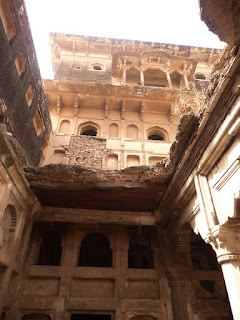I don’t know whether we actually
know the history of our cities or we just pretend about knowing it. I feel great, whenever I come across a well preserved monument and my happiness increases when i find it having an introduction (however
brief it may be) near its entrance and I begin to think that we indeed, do know something about
our history.
On the other hand, I have seen
several equally remarkable monuments which seem to have so much information
about the past but they are in a completely neglected state. Instead of having a much deserved introductory board, they don’t even have
the trespassers warning sign board. The
situation becomes even more ugly when you visit the building and see it covered
with the writings from 17th century and when you try to search this building on official websites and in local books, you end up finding absolutely nothing about it.
This forces me to believe that we actually know very less about our local history and adding to that, we are deliberately trying to ignore and destroying much more.
One such monument is situated on the outskirts of city of Naranul, inside the
premises of its famous Baba Kheta Nath Government Polytechnic College.
There are actually two monuments
inside this college. One is an unknown tomb (near its water tank).
Unknown old monument inside college
Other one
is a Bawdi(Baoli) situated at the centre.
Entry of the Bawdi(Baoli)
Bawdi from inside
This three story monument is actually a step-well, with one floor at sub-ground level. There are stairs at one side that goes all the way to the bottom of it and are perhaps separated
by a wall from a well on its other end.
The most remarkable thing about this monument are the writings on its walls, seems to have been written by people who had perhaps stayed here, during their journeys. These writings go back all the way from 21st century to 17th century. They are in Hindi,Urdu, Persian, Old broken Hindi (?) and even in English.
The most remarkable thing about this monument are the writings on its walls, seems to have been written by people who had perhaps stayed here, during their journeys. These writings go back all the way from 21st century to 17th century. They are in Hindi,
Writing on the wall
Another wall writing
Another writing in Urdu Persian
(as pointed out in comments section by Tarun Pant ji )
Thanks to dirt, webs and ignorance of our restoration
departments (which perhaps would have plastered over these walls, without even
bothering to chronicle these writings before doing so), these writings are still visible today.
I have taken photographs of as many as I could find there and some of them I am
posting here.
At least the oldest year mentioned in these would help us with a probable time of the construction of this building and also we would be able to find out, what kind of people used to visit the city and from where and with what purpose. So, in my opinion these writings are an important source of our history and deserve to be studied carefully.
At least the oldest year mentioned in these would help us with a probable time of the construction of this building and also we would be able to find out, what kind of people used to visit the city and from where and with what purpose. So, in my opinion these writings are an important source of our history and deserve to be studied carefully.
About Narnaul :- Naranul city is a part of Mohindergarh district. It is situated at a distance of 28 Km from Mohindergarh, 50 Km from Rewari and 150 Kms from Delhi and Jaipur.
About the Monument :- Both these monuments are situated inside the premises of BKN Govt. Polytechnic College which is situated on the outskirts of Naranul. It's better to take Narnaul- Nizampur road for reaching there. You have to take a link road on the left side after around 1-2 Km from Naranul, which would again be taking you back towards the city. You can ask anybody there about this college.
Co-ordinates of the monument :- 28°02’08.30” N and 76°06’01.40” E (for bawdi) and
28°02’12.00” N and 76°06’05.33” E (for the unknown monument)






_,_19th_century.jpg)






































